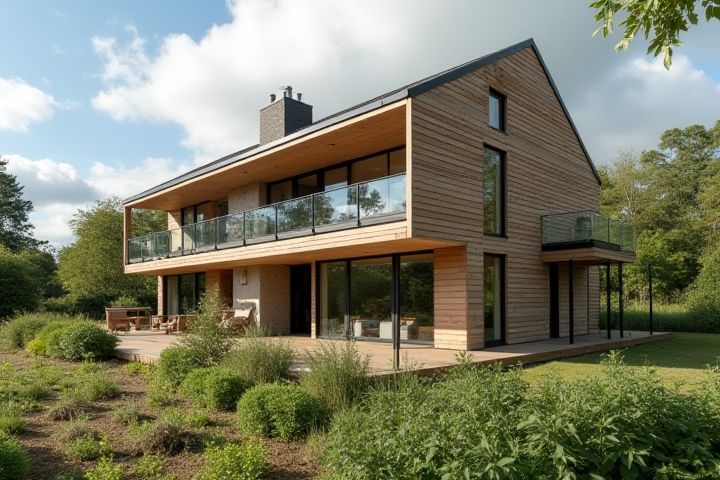
Sustainable house materials include bamboo, a rapidly renewable resource known for its strength and flexibility. Reclaimed wood, sourced from old structures, reduces landfill waste while providing unique character to new builds. Straw bales offer excellent insulation properties, making them an eco-friendly choice for energy-efficient homes. Recycled metal, like steel or aluminum, minimizes the demand for new mining operations, serving as a durable and versatile construction material. Additionally, incorporating natural insulation materials, such as sheep's wool or hemp, can enhance your home's sustainability by reducing its ecological footprint.
Which House Materials Are Sustainable
Bamboo
Bamboo is a highly sustainable building material, renowned for its rapid growth rate, reaching maturity in just 3 to 5 years compared to traditional hardwoods that can take decades. With a tensile strength comparable to steel, bamboo offers exceptional durability, making it an ideal choice for various construction applications, including flooring, furniture, and structural supports. This eco-friendly resource requires minimal pesticides and fertilizers, and its extensive root system helps prevent soil erosion, promoting ecological balance. By choosing bamboo for your projects, you contribute to reduced deforestation and lower carbon footprints, reinforcing a commitment to environmentally conscious living.
Recycled Steel
Recycled steel, derived from repurposing scrap metal, significantly reduces the need for virgin materials and conserves energy, using up to 75% less energy compared to new steel production. Every ton of recycled steel saves approximately 2,500 pounds of iron ore, 1,400 pounds of coal, and 120 pounds of limestone, illustrating its environmental benefits. Furthermore, steel is highly durable and can be recycled repeatedly without losing structural integrity, making it an ideal sustainable building material. Incorporating recycled steel into your construction projects can contribute to LEED certification, enhancing the overall sustainability profile of your home.
Rammed Earth
Rammed earth construction utilizes natural earth materials, specifically subsoil, which can be sourced locally to minimize transportation costs and environmental impact. This technique involves compacting earth mixed with gravel and sometimes organic materials into forms to create solid walls, showcasing excellent thermal mass that helps regulate indoor temperatures. The durability of rammed earth structures can exceed that of conventional materials, with minimal maintenance required over time. You can enhance sustainability by integrating renewable resources, such as recycled aggregates or natural fibers, further reducing the overall carbon footprint of the building project.
Reclaimed Wood
Reclaimed wood, often derived from old barns, factories, or wine casks, offers a sustainable building material that reduces the demand for new timber while preserving the environment. Utilizing reclaimed wood can decrease deforestation and lower greenhouse gas emissions, as each cubic meter of reclaimed wood saves approximately 1.1 tons of carbon dioxide. This material features unique characteristics, such as rich textures and historical significance, making it aesthetically appealing for your home design. With proper sourcing and treatment, reclaimed wood can maintain its durability for decades, providing a responsible choice for eco-conscious builders.
Straw Bales
Straw bale construction utilizes compacted straw from agricultural waste, making it an eco-friendly option for building homes. These bales provide excellent insulation properties, helping to maintain comfortable indoor temperatures while reducing energy consumption. Straw is renewable and biodegradable, contributing to a reduced carbon footprint compared to traditional materials like concrete or steel. You'll find that straw bale homes can also be cost-effective, offering durability and sustainability without compromising on style or comfort.
Cork
Cork, a sustainable building material harvested from the bark of cork oak trees, offers numerous eco-friendly advantages, including a renewable lifecycle every 9 to 10 years. Unlike traditional wood, cork harvesting does not require tree felling, allowing the trees to continue absorbing carbon dioxide, making it a crucial component in carbon footprint reduction. With a natural insulation value of around 0.040 W/m*K, cork effectively regulates temperature and reduces energy costs, contributing to a more efficient home. Its unique properties also include durability and resistance to fire, moisture, and pests, making cork an excellent choice for environmentally responsible construction.
Hempcrete
Hempcrete, a bio-composite material made from hemp hurds and lime, presents a sustainable alternative to traditional construction materials. This eco-friendly choice offers superior insulation qualities, reducing energy consumption for heating and cooling by up to 60%. Hempcrete is carbon-negative, sequestering more CO2 during its growth than is emitted during its life cycle, making it an excellent option for eco-conscious builders. With its low environmental impact and high durability, incorporating Hempcrete into your building projects can significantly enhance sustainability and promote a greener future.
Recycled Plastic
Recycled plastic in construction significantly reduces landfill waste, with approximately 8 million tons of plastic entering oceans each year. Utilizing recycled plastic, such as high-density polyethylene (HDPE) and polypropylene, contributes to durable building materials resistant to rot and pests. Homes constructed with these materials can achieve a higher sustainability rating, offering increased insulation and energy efficiency. You can also benefit from cost savings in maintenance and durability, making recycled plastic an attractive option for eco-friendly housing solutions.
Adobe
Adobe is a sustainable building material made from natural clay soil, sand, and straw, offering excellent thermal mass and insulation properties. This renewable resource not only minimizes carbon emissions during production but also effectively regulates indoor temperatures, enhancing energy efficiency. When properly maintained, adobe structures have a long lifespan, further contributing to their sustainability. You can find adobe used in various architectural styles, especially in arid climates, where its moisture-regulating capabilities help improve comfort and reduce reliance on artificial heating and cooling systems.
Mycelium
Mycelium, the root structure of fungi, has emerged as a pioneering sustainable building material due to its high renewability and low environmental impact. With the ability to grow in just a few weeks, mycelium can be cultivated on agricultural waste, effectively transforming organic by-products into valuable construction resources. This biodegradable material not only provides excellent insulation but also exhibits fire resistance and is lightweight, making it an innovative alternative to traditional materials. By opting for mycelium in your building projects, you contribute to a circular economy and reduce carbon emissions associated with conventional construction.
